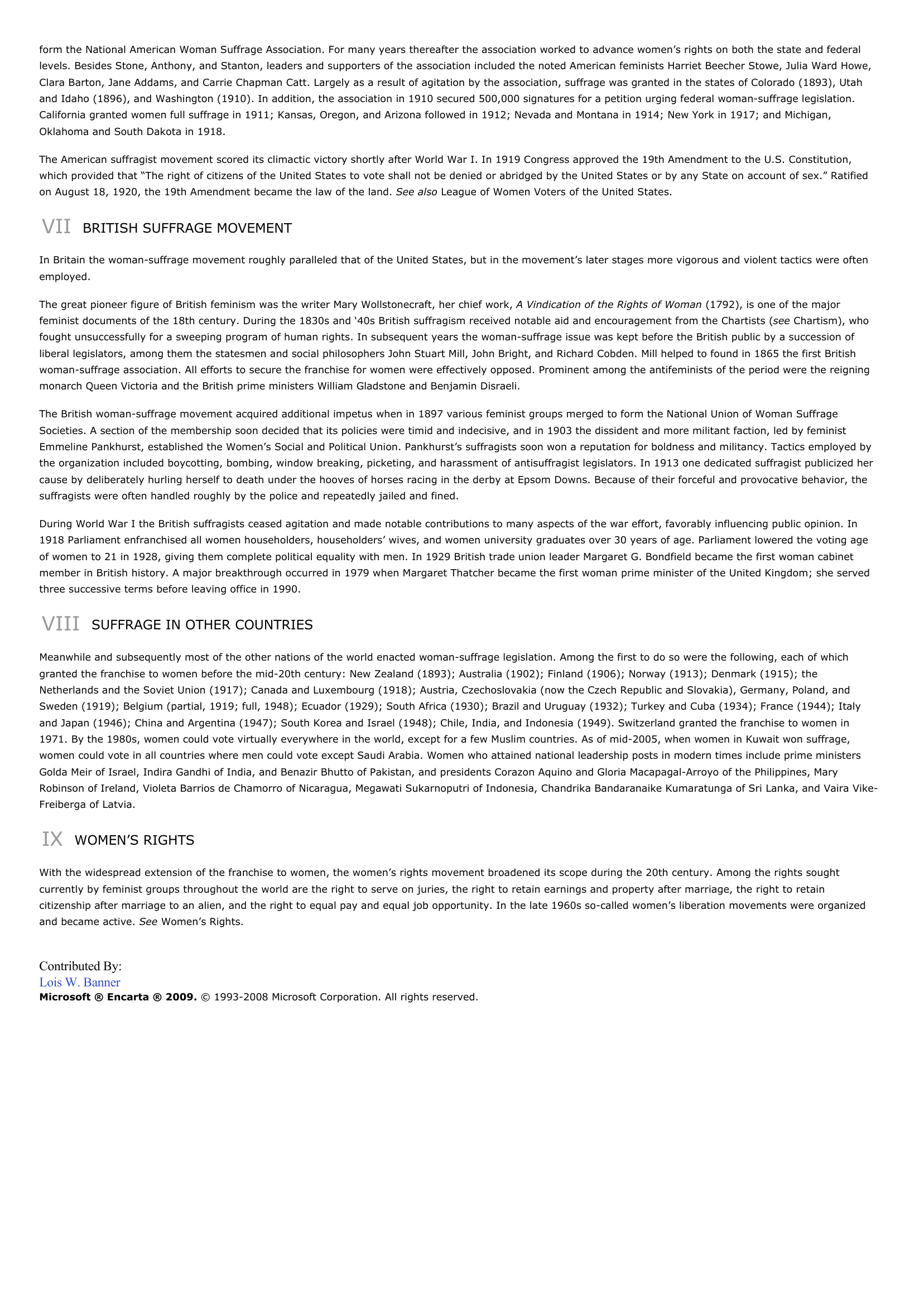Woman Suffrage - U.
Publié le 02/05/2013

Extrait du document
«
form the National American Woman Suffrage Association.
For many years thereafter the association worked to advance women’s rights on both the state and federallevels.
Besides Stone, Anthony, and Stanton, leaders and supporters of the association included the noted American feminists Harriet Beecher Stowe, Julia Ward Howe,Clara Barton, Jane Addams, and Carrie Chapman Catt.
Largely as a result of agitation by the association, suffrage was granted in the states of Colorado (1893), Utahand Idaho (1896), and Washington (1910).
In addition, the association in 1910 secured 500,000 signatures for a petition urging federal woman-suffrage legislation.California granted women full suffrage in 1911; Kansas, Oregon, and Arizona followed in 1912; Nevada and Montana in 1914; New York in 1917; and Michigan,Oklahoma and South Dakota in 1918.
The American suffragist movement scored its climactic victory shortly after World War I.
In 1919 Congress approved the 19th Amendment to the U.S.
Constitution,which provided that “The right of citizens of the United States to vote shall not be denied or abridged by the United States or by any State on account of sex.” Ratifiedon August 18, 1920, the 19th Amendment became the law of the land.
See also League of Women Voters of the United States.
VII BRITISH SUFFRAGE MOVEMENT
In Britain the woman-suffrage movement roughly paralleled that of the United States, but in the movement’s later stages more vigorous and violent tactics were oftenemployed.
The great pioneer figure of British feminism was the writer Mary Wollstonecraft, her chief work, A Vindication of the Rights of Woman (1792), is one of the major feminist documents of the 18th century.
During the 1830s and ‘40s British suffragism received notable aid and encouragement from the Chartists ( see Chartism), who fought unsuccessfully for a sweeping program of human rights.
In subsequent years the woman-suffrage issue was kept before the British public by a succession ofliberal legislators, among them the statesmen and social philosophers John Stuart Mill, John Bright, and Richard Cobden.
Mill helped to found in 1865 the first Britishwoman-suffrage association.
All efforts to secure the franchise for women were effectively opposed.
Prominent among the antifeminists of the period were the reigningmonarch Queen Victoria and the British prime ministers William Gladstone and Benjamin Disraeli.
The British woman-suffrage movement acquired additional impetus when in 1897 various feminist groups merged to form the National Union of Woman SuffrageSocieties.
A section of the membership soon decided that its policies were timid and indecisive, and in 1903 the dissident and more militant faction, led by feministEmmeline Pankhurst, established the Women’s Social and Political Union.
Pankhurst’s suffragists soon won a reputation for boldness and militancy.
Tactics employed bythe organization included boycotting, bombing, window breaking, picketing, and harassment of antisuffragist legislators.
In 1913 one dedicated suffragist publicized hercause by deliberately hurling herself to death under the hooves of horses racing in the derby at Epsom Downs.
Because of their forceful and provocative behavior, thesuffragists were often handled roughly by the police and repeatedly jailed and fined.
During World War I the British suffragists ceased agitation and made notable contributions to many aspects of the war effort, favorably influencing public opinion.
In1918 Parliament enfranchised all women householders, householders’ wives, and women university graduates over 30 years of age.
Parliament lowered the voting ageof women to 21 in 1928, giving them complete political equality with men.
In 1929 British trade union leader Margaret G.
Bondfield became the first woman cabinetmember in British history.
A major breakthrough occurred in 1979 when Margaret Thatcher became the first woman prime minister of the United Kingdom; she servedthree successive terms before leaving office in 1990.
VIII SUFFRAGE IN OTHER COUNTRIES
Meanwhile and subsequently most of the other nations of the world enacted woman-suffrage legislation.
Among the first to do so were the following, each of whichgranted the franchise to women before the mid-20th century: New Zealand (1893); Australia (1902); Finland (1906); Norway (1913); Denmark (1915); theNetherlands and the Soviet Union (1917); Canada and Luxembourg (1918); Austria, Czechoslovakia (now the Czech Republic and Slovakia), Germany, Poland, andSweden (1919); Belgium (partial, 1919; full, 1948); Ecuador (1929); South Africa (1930); Brazil and Uruguay (1932); Turkey and Cuba (1934); France (1944); Italyand Japan (1946); China and Argentina (1947); South Korea and Israel (1948); Chile, India, and Indonesia (1949).
Switzerland granted the franchise to women in1971.
By the 1980s, women could vote virtually everywhere in the world, except for a few Muslim countries.
As of mid-2005, when women in Kuwait won suffrage,women could vote in all countries where men could vote except Saudi Arabia.
Women who attained national leadership posts in modern times include prime ministersGolda Meir of Israel, Indira Gandhi of India, and Benazir Bhutto of Pakistan, and presidents Corazon Aquino and Gloria Macapagal-Arroyo of the Philippines, MaryRobinson of Ireland, Violeta Barrios de Chamorro of Nicaragua, Megawati Sukarnoputri of Indonesia, Chandrika Bandaranaike Kumaratunga of Sri Lanka, and Vaira Vike-Freiberga of Latvia.
IX WOMEN’S RIGHTS
With the widespread extension of the franchise to women, the women’s rights movement broadened its scope during the 20th century.
Among the rights soughtcurrently by feminist groups throughout the world are the right to serve on juries, the right to retain earnings and property after marriage, the right to retaincitizenship after marriage to an alien, and the right to equal pay and equal job opportunity.
In the late 1960s so-called women’s liberation movements were organizedand became active.
See Women’s Rights.
Contributed By:Lois W.
BannerMicrosoft ® Encarta ® 2009. © 1993-2008 Microsoft Corporation.
All rights reserved..
»
↓↓↓ APERÇU DU DOCUMENT ↓↓↓
Liens utiles
- DAME EN BLANC (La) [The Woman in White]. (résumé & analyse)
- FEMME D’ANDROS (La) [The Woman of Andros]. (résumé)
- ROUSSEAU: Comment le suffrage individuel peut-il se tromper dans le repérage de la volonté générale ?
- Descartes et suffrage
- Gambetta et le suffrage universel, Paris, Cirque du Château d'Eau, 9 octobre 1877.












